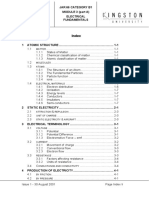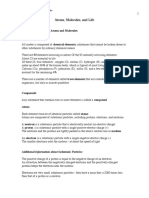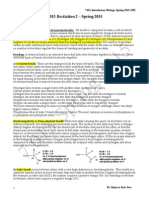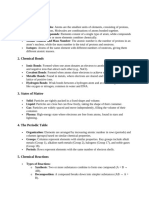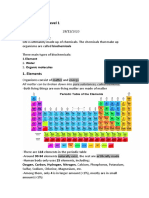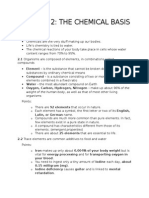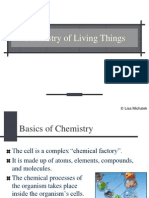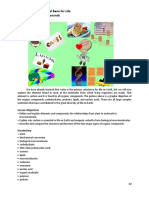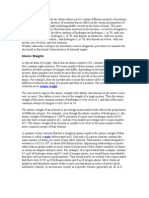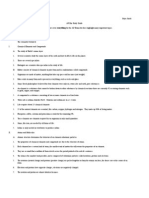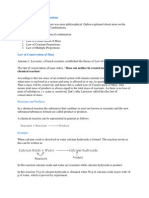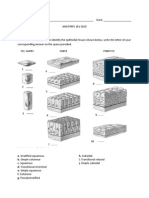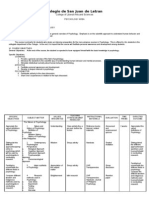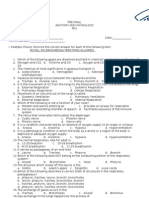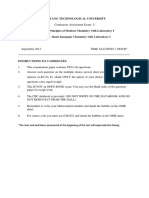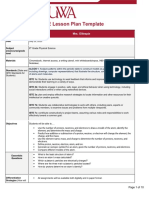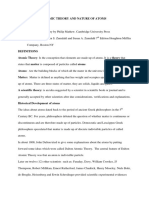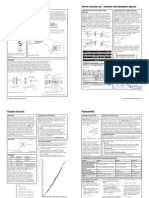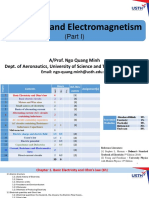The Chemistry of Life
The Chemistry of Life
Uploaded by
Ada Gay Olandia SerencioCopyright:
Available Formats
The Chemistry of Life
The Chemistry of Life
Uploaded by
Ada Gay Olandia SerencioCopyright
Available Formats
Share this document
Did you find this document useful?
Is this content inappropriate?
Copyright:
Available Formats
The Chemistry of Life
The Chemistry of Life
Uploaded by
Ada Gay Olandia SerencioCopyright:
Available Formats
The Chemistry of Life
Chemistry- is the scientific discipline concerned with the atomic composition and structure of substances and the reactions they undergo Matter- anything that occupies space and has mass Mass- is the amount of matter in an object Weight- is the gravitational force acting in an object of a given mass. Kilogram (kg)- international unit for mass Element- is the simplest type of matter with unique chemical properties Atom- is the smallest particle of an element that has the chemical characteristics of that element. Four elements make up 96 percent of all living material: 1. 2. 3. 4. Atomic Structure Atoms are made up of the subatomic particles protons and neutrons, which are in the atoms nucleus, and clouds of electrons orbiting the nucleus. The atomic weight, or mass, of an atom is the total number of protons and neutrons in its nucleus. The atomic number of an atom is its number of protons or electrons; conveniently, atoms always have the same number of protons as electrons, which means that an atom is always electrically neutral because it always has the same number of positive charges as negative charges. Opposite charges attract, so negatively charged electrons are attracted to positively charged protons. The attraction holds electrons in orbits outside the nucleus. The more protons there are in the nucleus, the stronger the atoms positive charge is and the more electrons it can attract. Electrons circle an atoms nucleus at different energy levels, also known as orbits or shells (see Figure 1-1). Each orbit can accommodate only a limited number of electrons and lies at a fixed distance from the nucleus. Each level must be filled to capacity with electrons before a new level can get started. The orbit closest to the nucleus, which may be referred to as the first level or first shell, can accommodate up to two electrons. The second level can have eight electrons and the third also can have eight electrons. Higher orbits exist, but anatomy and physiology students only need to know about the first three levels. Hydrogen, symbol H Oxygen, symbol O Nitrogen, symbol N Carbon, symbol C
Other key chemistry terms that you need to know as an anatomy and physiology student are: Isotopes: Atoms of an element that have a different number of neutrons and a different atomic weight than usual. In other words, isotopes are alternate forms of the same chemical element, so they will always have the same number of protons as that element, but a different number of neutrons. Ions: Because electrons are relatively far from the atomic nucleus, they are most susceptible to external fields. Atoms that have gained or lost electrons are transformed into ions. Getting an extra electron turns an atom into a negatively charged ion, or anion, whereas losing an electron creates a positively charged ion, or cation. To keep anions and cations straight, think like a compulsive dieter: Gaining is negative, and losing is positive. Acid: A substance that becomes ionized when placed in solution, producing positively charged hydrogen ions, H+. An acid is considered a proton donor. (Remember, atoms always have the same number of electrons as protons. Ions are produced when an atom gains or loses electrons.) Base: A substance that becomes ionized when placed in solution, producing negatively charged hydroxide ions, (OH) Bases are referred to as being more alkaline than acids and are known as proton acceptors. pH (potential of hydrogen): A mathematical measure on a scale of 0 to 14 of the acidity or alkalinity of a substance. A solution is considered neutral, neither acid nor base, if its pH is exactly 7. (Pure water has a pH of 7.) A substance is basic if its pH is greater than 7 and acidic if its pH is less than 7. Interestingly, skin is considered acidic because it has a pH around 5. Blood, on the other hand, is basic with a pH around 7.4. Compounding Chemical Reactions Atoms tend to arrange themselves in the most stable patterns possible, which means that they have a tendency to complete or fill their outermost electron orbits. They join with other atoms to do just that. The force that holds atoms together in collections known as molecules is referred to as a chemical bond. There are two main types and some secondary types of chemical bonds: 1. Ionic bond: This chemical bond (shown in Figure 1-2) involves a transfer of an electron, so one atom gains an electron while one atom loses an electron. One of the resulting ions carries a negative charge, and the other ion carries a positive charge. Because opposite charges attract, the atoms bond together to form a molecule.
2. Covalent bond: The most common bond in organic molecules, a covalent bond (shown in Figure 1-3) involves the sharing of electrons between two atoms. The pair of shared electrons forms a new orbit that extends around the nuclei of both atoms, producing a molecule. There are two secondary types of covalent bonds that are relevant to biology:
Polar bond: Two atoms connected by a covalent bond may exert different attractions for the electrons in the bond, producing an unevenly distributed charge. The result is known as a polar bond, an intermediate case between ionic and covalent bonding, with one end of the molecule slightly negatively charged and the other end slightly positively charged. Although the resulting molecule is neutral, at close distances the uneven charge distribution can be important. Water is an example of a polar molecule; the oxygen end has a slight positive charge whereas the hydrogen ends are slightly negative. Polarity explains why some substances dissolve readily in water and others do not. Hydrogen bond: Because theyre polarized, two adjacent H2O (water) molecules can form a linkage known as a hydrogen bond, where a (electronegative) hydrogen atom of one H2O molecule is electrostatically attracted to the (electropositive) oxygen atom of an adjacent water molecule. Consequently, molecules of water join together transiently in a hydrogen bonded lattice. Hydrogen bonds have only about 120 the stren gth of a covalent bond, yet even this force is sufficient to affect the structure of water, producing many of its unique properties, such as high surface tension, specific heat, and heat of vaporization. Hydrogen bonds are important in many life processes, such as in replication and defining the shape of DNA molecules. A chemical reaction is the result of a process that changes the number, the types, or the arrangement of atoms within a molecule. The substances that go through this process are called the reactants. The substances produced by the reaction are called the products. Chemical reactions are written in the form of an equation, with an arrow indicating the direction of the reaction. For instance: A + B AB. This equation translates to: Atom, ion, or molecule A plus atom, ion, or molecule B yields molecule AB. When elements combine through chemical reactions, they form compounds. When compounds contain carbon, theyre called organic compounds. The four families of organic compounds with important biological functions are: 1. Carbohydrates: These molecules consist of carbon, hydrogen, and oxygen in a ratio of roughly 1:2:1. If a test question involves identifying a compound as a carbohydrate, count the atoms and see if they fit that ratio. Carbohydrates are formed by the chemical reaction process of concentration, or dehydration
synthesis, and broken apart by hydrolysis, the cleavage of a chemical by a reaction that adds water. There are several subcategories of carbohydrates: a. Monosaccharides, also called monomers or simple sugars, are the building blocks of larger carbohydrate molecules and are a source of stored energy. Key monomers include glucose (also known as blood sugar), fructose, and galactose. These three have the same numbers of carbon (6), hydrogen (12), and oxygen (6) atoms in each molecule formally written as C6H12O6 but the bonding arrangements are different. Molecules with this kind of relationship are called isomers. b. Disaccharides, or dimers, are sugars formed by the bonding of two monosaccharides, including sucrose (table sugar), lactose, and maltose. c. Polysaccharides, or polymers, are formed when many monomers bond into long, chain-like molecules. Glycogen is the primary polymer in the body; it breaks down to form glucose, an immediate source of energy for cells. 2. Lipids: Commonly known as fats, these molecules contain carbon, hydrogen, and oxygen, and sometimes nitrogen and phosphorous. Insoluble in water because they contain a preponderance of nonpolar bonds, lipid molecules have six times more stored energy than carbohydrate molecules. Upon hydrolysis, however, fats form glycerol and fatty acids. A fatty acid is a long, straight chain of carbon atoms with hydrogen atoms attached (see Figure 1-5). If the carbon chain has its full number of hydrogen atoms, the fatty acid is saturated (examples include butter and lard). If the carbon chain has less than its full number of hydrogen atoms, the fatty acid is unsaturated (examples include margarine and vegetable oils). All fatty acids contain a carboxyl or acid group, COOH, at the end of the carbon chain. Phospholipids, as the name suggests, contain phosphorus and often nitrogen and form a layer in the cell membrane. Steroids are fat-soluble compounds such as vitamins A or D and hormones that often serve to regulate metabolic processes.
3. Proteins: Among the largest molecules, proteins can reach molecular weights of some 40 million atomic units. Proteins always contain the four HONC elements hydrogen, oxygen, nitrogen, and carbon and sometimes contain phosphorus and sulfur. The human body builds protein molecules using 20 different kinds of smaller molecules called amino acids (see Figure 1-6). Each amino acid molecule is composed of an amino group, NH2, and a carboxyl group, COOH, with a carbon chain between them. Amino acids link together by peptide bonds to form long molecules called polypeptides, which then assemble into proteins. Examples of proteins in the body include antibodies, hemoglobin (the red pigment in red blood cells), and enzymes (catalysts that accelerate reactions in the body).
4. Nucleic acids: These long molecules, found primarily in the cells nucleus, act as the bodys genetic blueprint. Theyre comprised of smaller building blocks called nucleotides. Each nucleotide, in turn, is composed of a five-carbon sugar (deoxyribose or ribose), a phosphate group, and a nitrogenous base. The nitrogenous bases in DNA (deoxyribonucleic acid) are adenine, thymine, cytosine, and guanine; they always pair off A-T and C-G. In RNA (ribonucleic acid), which occurs in a single strand, thymine is replaced by uracil, so the nucleotides pair off A-U and C-G. In 1953, James Watson and Francis Crick published their discovery of the three-dimensional structure of DNA a polymer that looks like a ladder twisted into a coil. They called this structure the double-stranded helix (see Figure 1-7).
Cycling through Life: Metabolism Metabolism (from the Greek metabole, which means change) is the word for the myriad chemical reactions that happen in the body, particularly as they relate to generating, storing, and expending energy. All metabolic reactions are either catabolic or anabolic. Catabolic reactions break food down into energy (memory tip: it can be catastrophic when things break down). Anabolic reactions require the expenditure of energy to build up compounds that the body needs. The chemical alteration of molecules in the cell is referred to as cellular metabolism. Enzymes can be used as catalysts, accelerating chemical reactions without being changed by the reactions. The molecules that enzymes react with are called substrates. Adenosine triphosphate (ATP) is a molecule that stores energy in a cell until the cell needs it. As the tri prefix implies, a single molecule of ATP is composed of three phosphate groups attached to a nitrogenous base of adenine. ATPs energy is stored in highenergy bonds that attach the second and third phosphate groups. (The high-energy bond is symbolized by a wavy line.) When a cell needs energy, it removes one or two of those phosphate groups, releasing energy and converting ATP into either the twophosphate molecule adenosine diphosphate (ADP) or the one-phosphate molecule adenosine monophosphate (AMP). (You can see ADP and ATP molecules in Figure 1-8.) Later, through additional metabolic reactions, the second and third phosphate groups are reattached to adenosine, reforming an ATP molecule until energy is needed again. Oxidation-reduction reactions are an important pair of reactions that occur in carbohydrate, lipid, and protein metabolism (see Figure 1-10). When a substance is oxidized, it loses electrons and hydrogen ions, removing a hydrogen atom from each molecule. When a substance is reduced, it gains electrons and hydrogen ions, adding a hydrogen atom to each molecule. Oxidation and reduction occur together, so whenever one substance is oxidized, another is reduced. The body uses this chemical-reaction pairing to transport energy in a process known as the respiratory chain, or the electron transport chain.
Carbohydrate metabolism involves a series of cellular respiration reactions, which are illustrated in Figure 1-9. All food carbohydrates are eventually broken down into glucose; therefore, carbohydrate metabolism is really glucose metabolism. Glucose metabolism produces energy that is then stored in ATP molecules. The oxidation process in which energy is released from molecules, such as glucose, and transferred to other molecules is called cellular respiration. It occurs in every cell in the body and it is the cells source of energy. The complete oxidation of one molecule of glucose will produce 38 molecules of ATP. It occurs in three stages: glycolysis, the Krebs cycle, and the electron transport chain: 1. Glycolysis From the Greek glyco (sugar) and lysis (breakdown), this is the first stage of both aerobic (with oxygen) and anaerobic (without oxygen) respiration. Using energy from two molecules of ATP and two molecules of NAD+ (nicotinamide adenine di-nucleotide), glycolysis uses a process called phosphorylation to convert a molecule of six-carbon glucose the smallest molecule that the digestive system can produce during the breakdown of a carbohydrate into two molecules of three-carbon pyruvic acid or pyruvate, as well as four ATP molecules and two molecules of NADH (nicotinamide adenine dinucleotide). Taking place in the cells Cytoplasm, glycolysis doesnt require oxygen to occur. The pyruvate and NADH move into the cells mitochondria, where an aerobic (with oxygen) process converts them into ATP. 2. Krebs cycle Also known as the tricarboxylic acid cycle or citric acid cycle, this series of energyproducing chemical reactions begins in the mitochondria after pyruvate arrives from glycolysis. Before the Krebs cycle can begin, the pyruvate loses a carbon dioxide group to form acetyl coenzyme A (acetyl CoA). Then acetyl CoA combines with a four-carbon molecule (oxaloacetic acid, or OAA) to form a sixcarbon citric acid molecule that then enters the Krebs cycle. The CoA is released intact to bind with another acetyl group. During the conversion, two carbon atoms are lost as carbon dioxide and energy is released. One ATP molecule is produced each time an acetyl CoA molecule is split. The cycle goes through eight steps, rearranging the atoms of citric acid to produce different intermediate molecules called keto acids. The acetic acid is broken apart by carbon (or decarboxylated) and oxidized, generating three molecules of NADH, one molecule of FADH2 (flavin adenine dinucleotide), and one molecule of ATP. The energy can be transported to the electron transport chain and used to produce more molecules of ATP. OAA is regenerated to get the next cycle going, and carbon dioxide produced during this cycle is exhaled from the lungs. 3. Electron transport chain The electron transport chain is a series of energy compounds attached to the inner mitochondrial membrane. The electron molecules in the chain are called cytochromes. These electron-transferring proteins contain a heme, or iron, group. Hydrogen from oxidized food sources attaches to coenzymes that in turn combine with molecular oxygen. The energy released during these reactions is used to attach inorganic phosphate groups to ADP and form ATP molecules. Pairs of electrons transferred to NAD+ go through the electron transport process and produce three molecules of ATP by oxidative phosphorylation. Pairs of electrons transferred to FAD enter the electron transport after the first phosphorylation and yield only two molecules of ATP. Oxidative phosphorylation is important because it makes energy available in a form the cells can use. At the end of the chain, two positively charged hydrogen molecules combine with two electrons and an atom of oxygen to form water. The final molecule to which electrons are passed is oxygen. Electrons are transferred from one molecule to the next, producing ATP molecules. Lipid metabolism only requires portions of the processes involved in carbohydrate metabolism. Lipids contain about 99 percent of the bodys stored energy and can be digested at mealtime, but as people who complain about fats going straight to their hips can attest, lipids are more inclined to be stored in adipose tissue the stuff generally identified with body fat. When the body is ready to metabolize lipids, a series of catabolic
reactions breaks apart two carbon atoms from the end of a fatty acid chain to form acetyl CoA, which then enters the Krebs cycle to produce ATP. Those reactions continue to strip two carbon atoms at a time until the entire fatty acid chain is converted into acetyl CoA. Protein metabolism focuses on producing the amino acids needed for synthesis of protein molecules within the body. But in addition to the energy released into the electron transport chain during protein metabolism, the process also produces byproducts, such as ammonia and keto acid. Energy is released entering the electron transport chain. The liver converts the ammonia into urea, which the blood carries to the kidneys for elimination. The keto acid enters the Krebs cycle and is converted into pyruvic acids to produce ATP. One last thing: That severe soreness and fatigue you feel in your muscles after strenuous exercise is the result of lactic acid buildup during anaerobic respiration. Glycolysis continues because it doesnt need oxygen to take place. But glycolysis does need a steady supply of NAD+, which usually comes from the oxygen-dependent electron transport chain converting NADH back into NAD+. In its absence, the body begins a process called lactic acid fermentation, in which one molecule of pyruvate combines with one molecule of NADH to produce a molecule of NAD+ plus a molecule of the toxic byproduct lactic acid.
You might also like
- P66616a Ial Physics Wph14 01Document32 pagesP66616a Ial Physics Wph14 01Little WizardNo ratings yet
- Chapter 2 The Chemical Level of OrganizationDocument17 pagesChapter 2 The Chemical Level of OrganizationO AfolabiNo ratings yet
- Quiz 2.1, 2.2, 2.3 Chemistry of LifeDocument5 pagesQuiz 2.1, 2.2, 2.3 Chemistry of LifenadiaNo ratings yet
- Behavioral Learning TheoryDocument26 pagesBehavioral Learning TheoryAda Gay Olandia Serencio50% (2)
- Gunshot & Shrapnel WoundsDocument11 pagesGunshot & Shrapnel WoundsAda Gay Olandia Serencio100% (1)
- Dragon Dreaming Fact SheetsDocument433 pagesDragon Dreaming Fact SheetsPeter DamocNo ratings yet
- 02 Assignment IDocument31 pages02 Assignment IINSPIRED STUDYNo ratings yet
- EASA Part 66 Module 3 Electrical Fundamentals Part A PDFDocument134 pagesEASA Part 66 Module 3 Electrical Fundamentals Part A PDFavijayakumar_1964No ratings yet
- A. Chemical Composition of The BodyDocument15 pagesA. Chemical Composition of The BodyShumail JANNo ratings yet
- Unit 1 Ch. 2 NotesDocument10 pagesUnit 1 Ch. 2 Notesanthony.brown2No ratings yet
- Unit 3 LectureDocument4 pagesUnit 3 Lecturesharafreem123No ratings yet
- 3 Chemical Basis of LifeDocument42 pages3 Chemical Basis of Lifemikel owen castilloNo ratings yet
- ChemistryDocument3 pagesChemistryzde20637No ratings yet
- The Nature of Matter: Atoms and MoleculesDocument6 pagesThe Nature of Matter: Atoms and Moleculesmelan pNo ratings yet
- 02 SNSNSJDocument10 pages02 SNSNSJCeriseNo ratings yet
- Basic Chemistry Review: Earth and Space ScienceDocument48 pagesBasic Chemistry Review: Earth and Space SciencefluronineNo ratings yet
- Matter: Elements and Compounds MatterDocument39 pagesMatter: Elements and Compounds MattercarloNo ratings yet
- CH 02 Outline and Summary NotesDocument8 pagesCH 02 Outline and Summary NotesDaniel PerezNo ratings yet
- Chapter 2 The Chemical Basis of LifeDocument11 pagesChapter 2 The Chemical Basis of LifeEuniece AnicocheNo ratings yet
- Unit 1 SummaryDocument10 pagesUnit 1 Summarylucas.m.weltyNo ratings yet
- Chapter 2 The Chemical Basis of LifeDocument6 pagesChapter 2 The Chemical Basis of Lifemzunl25476100% (1)
- Hidzqi SA - 15A - Assingment 3Document2 pagesHidzqi SA - 15A - Assingment 3hidzqiNo ratings yet
- Chapter 2 Basic ChemistryDocument25 pagesChapter 2 Basic ChemistryBAYA, ZSEANNEL RAIVEN V.No ratings yet
- Introduction To ChemistryDocument35 pagesIntroduction To Chemistryzeeshan783aminNo ratings yet
- Chemistry: Role of Chemistry in Modern LifeDocument7 pagesChemistry: Role of Chemistry in Modern LifeLoLo AlobaidyNo ratings yet
- Basic Biology I: Cells: How Organisms WorkDocument57 pagesBasic Biology I: Cells: How Organisms WorkGorby ResuelloNo ratings yet
- Chemicals of LifeDocument4 pagesChemicals of LifeZoeNo ratings yet
- ChemistryNotesDocument3 pagesChemistryNotessuju.miracleNo ratings yet
- Anatomy and PhysiologiDocument10 pagesAnatomy and PhysiologiRivaldiNo ratings yet
- General ChemistryDocument6 pagesGeneral ChemistryJewel ValenciaNo ratings yet
- Bio NotesDocument8 pagesBio Notespanda catNo ratings yet
- Sample IntroductionDocument12 pagesSample Introductionapi-289866381No ratings yet
- DP Life Science Level 1: All Matter Can Be Broken Down Into Pure Substances, Called ElementsDocument13 pagesDP Life Science Level 1: All Matter Can Be Broken Down Into Pure Substances, Called ElementshjkadjfasdfaNo ratings yet
- Gen Chem 1 - Handout - Q2 - Weeks 5 7Document15 pagesGen Chem 1 - Handout - Q2 - Weeks 5 7Keyaru HealerNo ratings yet
- The Chemical Foundation of LIfeDocument29 pagesThe Chemical Foundation of LIfehurainsahar21No ratings yet
- Chap 4 BIOLOGY BIODocument82 pagesChap 4 BIOLOGY BIOsarah575No ratings yet
- Chapter 2: The Chemical Basis of LifeDocument6 pagesChapter 2: The Chemical Basis of LifeThalia LauNo ratings yet
- Chapter 2: The Chemical Context of LifeDocument35 pagesChapter 2: The Chemical Context of LifeJustin RobenyNo ratings yet
- Basic Terminology in ChemistryDocument4 pagesBasic Terminology in ChemistryHaider JalalNo ratings yet
- Biology Olympiad: Module 1: IntroductionDocument36 pagesBiology Olympiad: Module 1: IntroductionSamarjeet SalujaNo ratings yet
- Bio Study SheetDocument9 pagesBio Study SheetJennyNo ratings yet
- Anatomy and Physiology ChemistryDocument49 pagesAnatomy and Physiology ChemistryNoahSullivanNo ratings yet
- Chap 2 Macromolecules 120711Document93 pagesChap 2 Macromolecules 120711Re CarlNo ratings yet
- Chemistry GuideDocument50 pagesChemistry Guidesssvlogs09No ratings yet
- The Chemical Earth-Ahmad ShahDocument46 pagesThe Chemical Earth-Ahmad ShahYouseffNo ratings yet
- Chemistry of Living ThingsDocument47 pagesChemistry of Living Thingsapi-2174392830% (1)
- B. Chapter 3 Lesson 2-Organic CompoundsDocument20 pagesB. Chapter 3 Lesson 2-Organic CompoundsShelrenNo ratings yet
- Ch2 Explaining ChemistryDocument2 pagesCh2 Explaining ChemistryztolmanNo ratings yet
- Chapter 2 Basic ChemistryDocument3 pagesChapter 2 Basic ChemistryMayross GoldNo ratings yet
- Anaphy L2Document15 pagesAnaphy L2wattpadknightNo ratings yet
- Official Biology 102 Course Package (2011) by Tyler Vance and Megan Valencia PDFDocument88 pagesOfficial Biology 102 Course Package (2011) by Tyler Vance and Megan Valencia PDFreadingisgudNo ratings yet
- AP Bio Big Study GuideDocument33 pagesAP Bio Big Study GuideHayden CaseyNo ratings yet
- Distinguish Between The Following Pairs of TermsDocument3 pagesDistinguish Between The Following Pairs of Terms쥬얼이No ratings yet
- Chapter 2 PPDocument43 pagesChapter 2 PPChenel PierceNo ratings yet
- Ma. Eloisa R. Jurilla: Humss X1 - ADocument44 pagesMa. Eloisa R. Jurilla: Humss X1 - AcatrinaNo ratings yet
- Chemistry GuideDocument28 pagesChemistry Guidesssvlogs09No ratings yet
- 2 1 OverviewDocument34 pages2 1 Overviewapi-262378640No ratings yet
- CHM 111 - 7 Feb 2024 - NoteDocument16 pagesCHM 111 - 7 Feb 2024 - Notedenzellarry67No ratings yet
- Atoms and Molecules: Laws of Chemical CombinationsDocument10 pagesAtoms and Molecules: Laws of Chemical Combinationsneeraj2468No ratings yet
- Intro To Physiology FullDocument67 pagesIntro To Physiology Fullmuhammadsohail3850No ratings yet
- Mader/Biology, 11/e - Chapter Outline: 2.1 Chemical ElementsDocument3 pagesMader/Biology, 11/e - Chapter Outline: 2.1 Chemical Elementsapi-455371000No ratings yet
- Carbon and The Molecular Diversity of LifeDocument4 pagesCarbon and The Molecular Diversity of LifesamNo ratings yet
- Appendix E - Polarity WorksheetDocument3 pagesAppendix E - Polarity WorksheetshafferjfNo ratings yet
- A-Level Chemistry Revision: Cheeky Revision ShortcutsFrom EverandA-Level Chemistry Revision: Cheeky Revision ShortcutsRating: 4 out of 5 stars4/5 (5)
- Serencio AdaGay Requirement3 PDFDocument1 pageSerencio AdaGay Requirement3 PDFAda Gay Olandia SerencioNo ratings yet
- Identification of Person and A Material (Cont.) : Ada Gay O. Serencio, RNDocument28 pagesIdentification of Person and A Material (Cont.) : Ada Gay O. Serencio, RNAda Gay Olandia SerencioNo ratings yet
- Ra 10575Document2 pagesRa 10575Ada Gay Olandia Serencio100% (8)
- Name: - Date: - Anatomy 101 QuizDocument2 pagesName: - Date: - Anatomy 101 QuizAda Gay Olandia SerencioNo ratings yet
- Newborn Care ChecklistDocument5 pagesNewborn Care ChecklistAda Gay Olandia SerencioNo ratings yet
- Administering Oral MedicationsDocument5 pagesAdministering Oral MedicationsAda Gay Olandia SerencioNo ratings yet
- 2006 - Psych 101 - General PsychologyDocument7 pages2006 - Psych 101 - General PsychologyAda Gay Olandia SerencioNo ratings yet
- AnatomyDocument3 pagesAnatomyAda Gay Olandia SerencioNo ratings yet
- Individual Health RecordDocument1 pageIndividual Health RecordAda Gay Olandia SerencioNo ratings yet
- Chemistry: Stage 1 - Desired ResultsDocument9 pagesChemistry: Stage 1 - Desired ResultsAmor BatasNo ratings yet
- Chemistry - Foundation Material 2022-23Document49 pagesChemistry - Foundation Material 2022-23VenkyNo ratings yet
- Chemistry IX Paper I 2023Document12 pagesChemistry IX Paper I 2023sumi nbNo ratings yet
- Cm1021-Ca-1-2012-Answer KeyDocument4 pagesCm1021-Ca-1-2012-Answer KeyJoey Tay Wei YingNo ratings yet
- Basic Concepts of The Vehicle Electrical System - BMWDocument32 pagesBasic Concepts of The Vehicle Electrical System - BMWMTK2016No ratings yet
- Gillespie 5e Lesson PlanpdfDocument10 pagesGillespie 5e Lesson Planpdfapi-677982605No ratings yet
- Atomic Theory PowerpointDocument25 pagesAtomic Theory PowerpointRolly EgasNo ratings yet
- General ChemistryDocument10 pagesGeneral Chemistryhehe xdNo ratings yet
- Basic Electronics For SeafarersDocument209 pagesBasic Electronics For SeafarersАЛЕКСЕЙ ЕРМОШКИНNo ratings yet
- Electric Charge, Additivity of Charges, Conservation and QuDocument2 pagesElectric Charge, Additivity of Charges, Conservation and Qurajstudybri0% (1)
- Module 1Document1 pageModule 1Marcjun Colmo AlegradoNo ratings yet
- Millman HakyaisDocument342 pagesMillman HakyaisBharat BadhanNo ratings yet
- (AI For Everything) Volker Knecht - AI For Physics - Machine Learning The World From Nuclear To Cosmic Scales-CRC Press (2022)Document149 pages(AI For Everything) Volker Knecht - AI For Physics - Machine Learning The World From Nuclear To Cosmic Scales-CRC Press (2022)MONEY MINDED MILLENNIAL100% (1)
- Chemistry 101 Week 2 NotesDocument3 pagesChemistry 101 Week 2 NotesMatthew WieseNo ratings yet
- Set 7 Paper 2Document19 pagesSet 7 Paper 2Miesya87No ratings yet
- 1-Atomic Theory and Nature of Atoms - Lecture 1Document8 pages1-Atomic Theory and Nature of Atoms - Lecture 1sophiaccharlotte876No ratings yet
- Atoms and The Periodic TableDocument13 pagesAtoms and The Periodic TableAnonymous Bv0YpFNo ratings yet
- 4 1 - Atomic Theory BondingDocument38 pages4 1 - Atomic Theory Bondingapi-309810985No ratings yet
- UHS MCAT Entry Test Syllabus 2014Document55 pagesUHS MCAT Entry Test Syllabus 2014medicalkidunya100% (1)
- Atomic Structure and The Periodic TableDocument3 pagesAtomic Structure and The Periodic TableKhoer Ummah100% (1)
- 97 Information and Questions SheetDocument4 pages97 Information and Questions SheetMilintorn WongchinchaiNo ratings yet
- USTH ElectricityAndElectromagnetismI AE Part1 Lecture 01Document25 pagesUSTH ElectricityAndElectromagnetismI AE Part1 Lecture 01Tran Sy LoiNo ratings yet
- G9 - NCERT - Structure of The Atom PDFDocument14 pagesG9 - NCERT - Structure of The Atom PDFSai AravapalliNo ratings yet
- Nuclear StabilityDocument21 pagesNuclear StabilityDr-naser MahmoudNo ratings yet
- Atoms: Frederick A. Bettelheim William H. Brown Mary K. Campbell Shawn O. FarrellDocument45 pagesAtoms: Frederick A. Bettelheim William H. Brown Mary K. Campbell Shawn O. FarrellShereen Al-ObinayNo ratings yet
- Homework #03 (Phy 112) SolutionsDocument9 pagesHomework #03 (Phy 112) SolutionsKvn4N6No ratings yet







